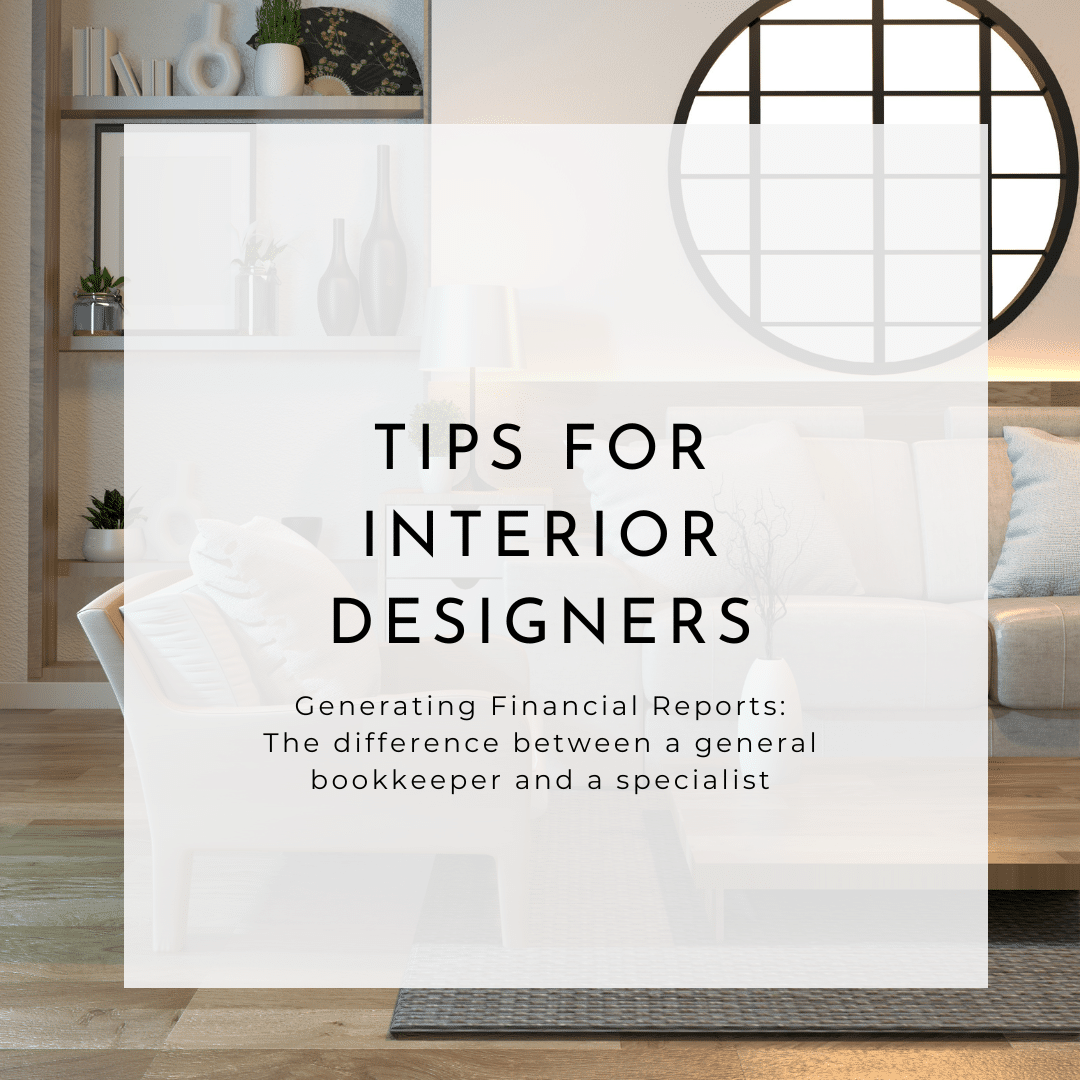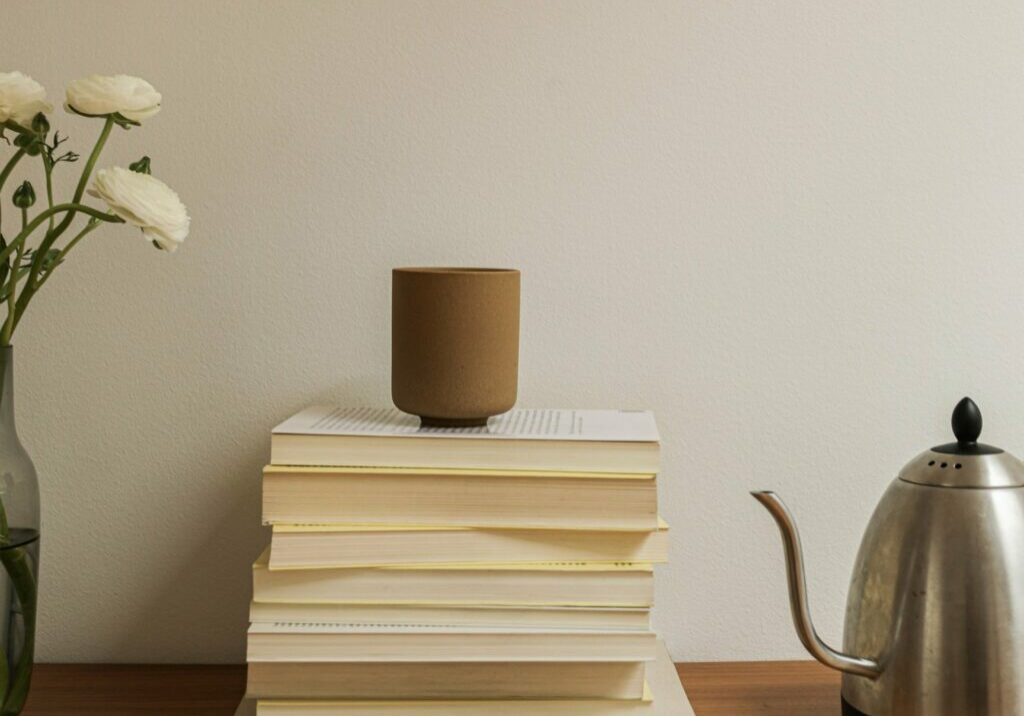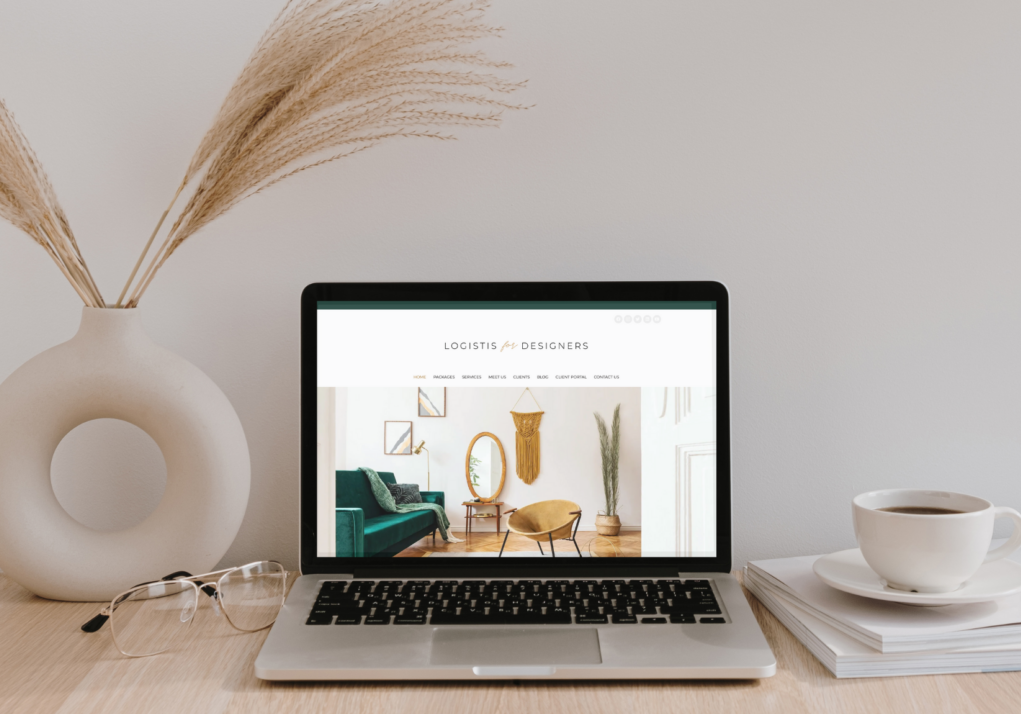When I talk with interior designers about financial reporting and analysis, I often get one of two reactions: either glazed-over eyes or immediate anxiety. Both reactions come from the same place—a disconnect between your creative work and the financial side of your business.
Without accurate measurements and specifications, even the most beautiful design concept will fail during implementation. The same goes for your business finances.
Interior design firms face unique financial challenges that general accounting approaches simply don’t address. From project-based accounting to complex sales tax issues, the financial landscape for designers requires specialized knowledge to be able to manage successfully.

With proper financial reporting and analysis, you’ll be able to:
- Identify which types of projects generate the most profit
- Make informed decisions about pricing your services
- Track your actual profitability, not just revenue
- Plan for growth with confidence
- Take home more of what you earn
But first, you need to know which financial reports actually matter for your interior design business.
The Financial Statements You Need To Know
To get a handle on your finances, you need to understand the three core financial statements: the Income Statement, the Balance Sheet, and the Cash Flow Statement. Let’s break them down:
Income Statement
The Income Statement, often called the Profit & Loss (P&L) statement, summarizes your revenues, costs, and expenses over a specific period (e.g., a month, quarter, or year). It shows whether your business is making a profit or a loss.
- Revenue: Total income generated from your design projects, services, and product sales.
- Cost of Goods Sold (COGS): Direct costs associated with the goods you sell, such as furniture, materials, and accessories. We will talk more about COGS later.
- Gross Profit: Revenue minus COGS. This is a critical number!
- Operating Expenses: Costs to run your business, including rent, salaries, marketing, and administrative expenses.
- Net Income: Your bottom line – the profit (or loss) remaining after deducting all expenses from revenue.
How to use it
Analyze your P&L statement to identify trends in revenue, track your gross profit margin, and control operating expenses. Are project costs eating into your profits? Is marketing delivering a good return on investment? Financial reporting and analysis will help you make these types of decisions!
Balance Sheet
The Balance Sheet provides a snapshot of your firm’s financial position at a specific moment. It outlines what you own (assets), what you owe (liabilities), and your net worth (equity). It follows the basic accounting equation:
Assets = Liabilities + Equity
- Assets: What your business owns, including cash, accounts receivable (money owed to you by clients), inventory, and equipment.
- Liabilities: What your business owes to others, including accounts payable (money you owe to suppliers), loans, and deferred revenue (client deposits).
- Equity: The owner’s stake in the business – your personal investment and retained earnings.
How to use it
The balance sheet reveals your firm’s financial strength. Can you pay your short-term debts? Do you have too much debt compared to equity? Are your assets growing over time?
Cash Flow Statement
The Cash Flow Statement tracks the movement of cash both into and out of your business over a period. It’s so important for understanding how well you manage your cash flow, which is the lifeblood of your business. Managing cash flow fluctuations is key to running a design firm.
- Operating Activities: Cash flow from your core business activities, such as design services, sales, and related expenses.
- Investing Activities: Cash flow from purchasing or selling long-term assets, like equipment or property.
- Financing Activities: Cash flow from borrowing money, repaying debt, or raising equity.
How to use it
The cash flow statement helps you anticipate cash shortages, manage expenses, and ensure you have enough cash on hand to meet your obligations. Can you cover payroll and vendor payments? Do you need to improve your collection process?
Specialized Financial Metrics
Beyond the basic financial statements, a few key metrics are especially relevant to interior design firms:
Project Profitability Analysis: Evaluating Project Success
This involves tracking the revenue, costs, and expenses associated with each individual project to determine its profitability. This goes hand in hand with financial reporting and analysis of your design projects.
- Direct Costs: Materials, labor, subcontractor fees directly tied to the project.
- Indirect Costs: Overhead expenses allocated to the project (e.g., rent, utilities).
- Profit Margin: (Revenue – Total Costs) / Revenue. The higher, the better!
Real-World Application
Imagine you complete two projects: A and B. Project A seemed successful and it brought in a lot of money. However after you track it and Project B, you discover that Project A has a poor profit margin. Without tracking this metric, you may not be seeing the full picture when it comes to each project. Use tools like Houzz Pro to easily track and analyze project profitability!
Measuring Utilization Rates
Utilization rate measures the percentage of your team’s time that is spent on billable activities (i.e., working directly on client projects). It basically tells you how efficient your team is.
- Billable Hours: Time spent on client projects.
- Total Available Hours: Total hours worked by your team.
- Utilization Rate: (Billable Hours / Total Available Hours) x 100%.
The Takeaway
A high utilization rate signals that your team is productive and generating revenue. A low rate suggests inefficiencies in project management or a need to ramp up your sales process.
Overhead Rate Calculation
Overhead rate is the percentage of your revenue that goes towards covering indirect costs (e.g., rent, utilities, administrative salaries).
- Total Overhead Costs: All those indirect expenses that keep the lights on.
- Total Revenue: The total income generated by your firm.
- Overhead Rate: (Total Overhead Costs / Total Revenue) x 100%.
This metric is crucial for accurately pricing your services and ensuring you’re covering all your costs. Ensure accurate sales tax liability, especially with multi-state filings, and you’re on the right track.
Financial Management Best Practices
Effective financial management is about implementing processes that help you control your finances and achieve your business goals.
Planning for the Future
Budgeting involves creating a detailed plan of your expected revenues and expenses for a specific period. Forecasting takes it a step further by projecting your financial performance based on different scenarios and assumptions.
- Historical Data: Review past financial statements to identify trends and patterns.
- Market Analysis: Research industry trends and economic conditions. What’s happening in the design world?
- Sales Projections: Estimate future sales based on your marketing efforts and client pipeline.
- Expense Planning: Identify and budget for all your operating expenses.
Why it matters
Budgeting and forecasting help you anticipate challenges, set realistic goals, and make informed investment decisions.
Monitoring Operational Costs
Detailed expense tracking is necessary if you want to understand where your money is going and identify opportunities to cut costs.
- Categorize Expenses: Group expenses into logical categories like rent, salaries, marketing, and supplies.
- Use Accounting Software: Implement a system to track expenses electronically.
- Regularly Review Expenses: Analyze your spending patterns and identify areas for improvement.
Here’s Why You Should Care
Expense tracking isn’t just about knowing where your money goes. It’s about finding ways to optimize your spending, boost your profitability, and make better financial decisions. QBO (QuickBooks Online) can help!
Pricing Strategies for Profitability
Setting the right prices for your services and products is essential for achieving your desired profit margins. Interior designers may need to manage inventory, including furnishings, materials, and accessories.
- Cost-Plus Pricing: Calculate your costs and add a markup to determine your price.
- Value-Based Pricing: Price your services based on the value you provide to your clients.
- Competitive Pricing: Research what your competitors are charging and price your services accordingly.
Why it matters
Effective pricing ensures you’re covering your costs, generating a profit, and staying competitive.
Financial Reporting Best Practices
To make sure you’re getting the most out of your financial reporting, keep these best practices in mind:
- Consistency is Key: Use the same accounting methods and reporting periods consistently for accurate comparisons.
- Regular Review: Review reports regularly to identify trends and take corrective action.
- Seek Professional Advice: Consult with a qualified accountant or financial advisor for guidance.
Taxation & Compliance
Tax compliance is a critical aspect of financial management for interior designers.
Federal and State Requirements
As a business owner, you’re responsible for paying federal and state taxes, including income tax, self-employment tax, and payroll taxes (if you have employees). Revenue recognition can be complex in the interior design industry, as revenue is usually recognized over the duration of the project rather than at the time of sale.
- Consult with a Tax Professional: Seek guidance from a qualified accountant or tax advisor.
- Keep Accurate Records: Maintain detailed records of your income and expenses.
- File Taxes on Time: Adhere to all tax deadlines to avoid penalties. Nobody wants to get in trouble with the IRS!
Here’s a Pro Tip
A lot of interior designers make the mistake of waiting until tax season to get their finances in order. But by working with a tax professional year-round, you can proactively plan for taxes, identify potential deductions, and minimize your tax liability.
Services and Products
Interior designers often sell both services and products, which may be subject to sales tax. The rules vary by state, so it’s important to understand what is expected of you. Sales tax and reselling goods for interior designers can be tricky.
- Determine Taxability: Identify which of your services and products are subject to sales tax.
- Collect Sales Tax: Charge the appropriate sales tax rate to your clients.
- Remit Sales Tax: File and pay your sales tax obligations to the state on time.
Why it matters
Non-compliance with sales tax laws can result in penalties and legal trouble.
Financial Reporting Standards
Financial reporting standards evolve over time.
- Follow Industry News: Stay up-to-date on accounting and tax developments.
- Attend Professional Development Courses: Enhance your knowledge of financial reporting.
- Consult with Experts: Seek guidance from accountants and financial advisors.
Why it matters
Adhering to current standards ensures the credibility and reliability of your financial information.
Overcoming Financial Challenges
Interior design firms face unique financial challenges. Here’s how to tackle some of the most common ones:
Strategies for Stability
Cash flow can fluctuate significantly, especially with project-based work. Client Deposits and Retainers for interior designers are key.
- Build a Cash Reserve: Set aside funds to cover unexpected expenses or slow periods.
- Improve Your Collection Process: Send invoices promptly and follow up on overdue payments.
- Offer Payment Plans: Provide clients with flexible payment options to encourage timely payments.
Why it matters
Managing cash flow fluctuations ensures you can meet your financial obligations and maintain stability.
Ensuring Timely Collections
Late payments can mess with your cash flow. Your accountant also plays a vital role in how you manage subcontractors and suppliers.
- Set Clear Payment Terms: Communicate your payment expectations upfront.
- Send Payment Reminders: Send reminders before payment deadlines.
- Consider Late Payment Fees: Implement a policy for charging late fees.
Why it matters
Proactive measures improve your collection rate and reduce the impact of delays.
Maintaining Financial Stability
Economic downturns can significantly impact the interior design industry.
- Cut Costs: Identify areas to reduce expenses without sacrificing quality.
- Diversify Your Services: Offer a wider range of services to attract new clients.
- Focus on Marketing: Invest in marketing to maintain a steady stream of leads.
Why it matters
Adapting to economic challenges helps you maintain financial stability and position your firm for long-term success.
The Benefits Of Professional Financial Assistance
Knowing when to seek professional financial assistance is crucial for making informed decisions.
When to Consult a CFO or Financial Advisor
As your business grows, you may need more advanced financial guidance.
- Complex Financial Decisions: When facing significant investments, mergers, or acquisitions.
- Strategic Planning: When developing long-term business strategies.
- Raising Capital: When seeking funding from investors or lenders.
Why it matters
A CFO or financial advisor can provide expert advice and help you make informed decisions about your firm’s future. Consider CFO Services from Logistis For Designers as a solution!
Financial reporting and analysis are essential for building a successful business! Understand financial statements, track key metrics, and make informed decisions. Take charge of your finances and unlock your firm’s potential! Download our guide on ways to build a profitable design business to get started or contact us now to schedule a consultation.
FAQs
What is the primary purpose of financial reporting in interior design?
Financial reporting helps interior designers track profitability, manage cash flow, and make informed business decisions. It’s essential for business growth and stability.
How do I calculate project profitability?
Project profitability is calculated by subtracting total project costs from project revenue. Use tools like Houzz Pro to streamline this process.
What is the importance of budgeting and forecasting?
Budgeting and forecasting help you anticipate financial challenges, set realistic goals, and make strategic decisions for business growth.
Why is it important to track utilization rates?
Tracking utilization rates helps you measure team productivity and identify areas for improvement in project management and resource allocation.
What are the benefits of hiring a specialized accountant?
Specialized accountants understand the unique financial challenges of the interior design industry, offering tailored advice and services to improve financial performance.
How can I manage cash flow fluctuations?
Build a cash reserve, improve your collection process, and offer flexible payment plans to clients to manage cash flow effectively.
What are the key tax obligations for interior designers?
Interior designers must comply with federal and state tax laws, including income tax, self-employment tax, and sales tax obligations.
Share On:



